Having a dog means making a commitment to love and care for them to the best of your ability. This means knowing what their dietary needs are to keep them healthy so they can live a long happy life. Different size dogs not only need different amounts of food but also different types.
There are plenty of dog food brands that have specific food for toy/small dogs, medium dogs, large dogs, and giant dogs. Different-sized dogs need different foods, and so do different ages.
Puppies need more food per day as well as more fat and protein in their food. Growing pups burn a lot of energy and as they grow they need food that will support healthy joint and bone development. When your dog ages you can start to adjust its diet to cater to its breed. Large dog breed owners typically start to add supplements for joint health while they’re young since larger breeds are more prone to joint injury.
As your dog grows its metabolism will change and its health may decline. Keeping a feeding schedule and maintaining a healthy amount of nutritious food is key to prolonging your furry friend’s lifespan. To better understand how much you should feed the type of dog you have, we’ve made a dog feeding guide by size, age, and weight.
How Can Too Little or Too Much Food Affect Your Dog?
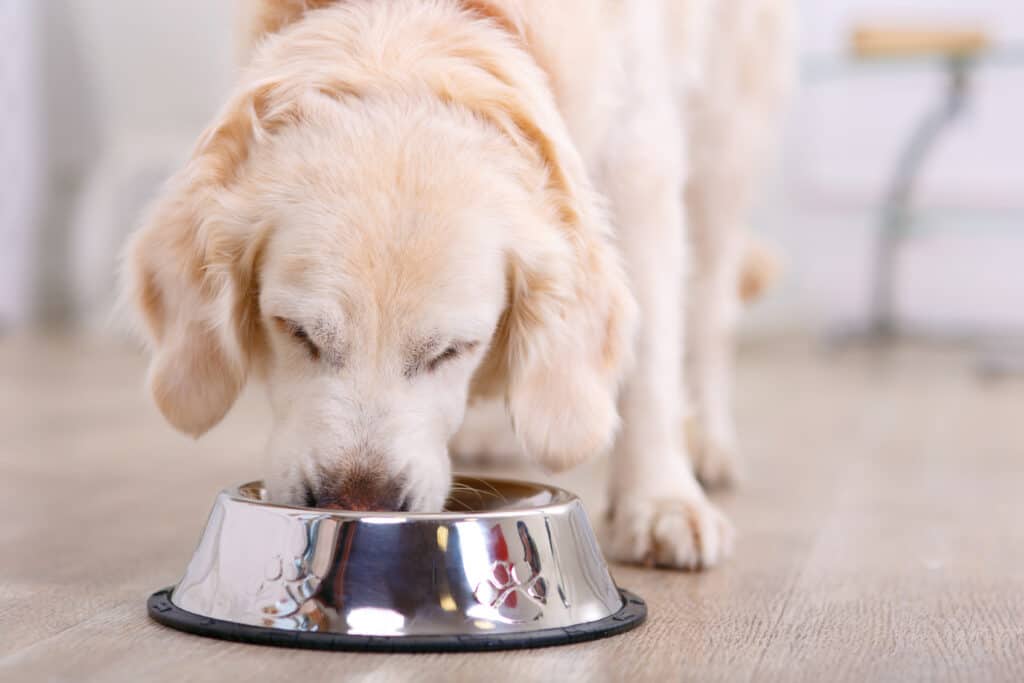
Feeding the correct amount of food for your dog’s size is essential to maintaining a healthy pet
©Dmytro Zinkevych/Shutterstock.com
Knowing how much you should feed your dog is important for many reasons. Giving your pooch the right amount of food that’s good for them is essential. It helps keep your pet healthy and helps prevent a variety of health issues such as;
- Congestive heart failure
- Shortened life span
- Cushing’s disease
- Skin conditions
- Asthma
- Certain forms of cancer
Too little food can make your dog weak, and more prone to illness. Dogs that are too heavy are also at risk for various illnesses and will be overall less healthy.
Feeding your correctly is essential for their health age following the feeding rules for their weight, size, and age is very important.
Toy Breeds (1-15lbs) Feeding Rules
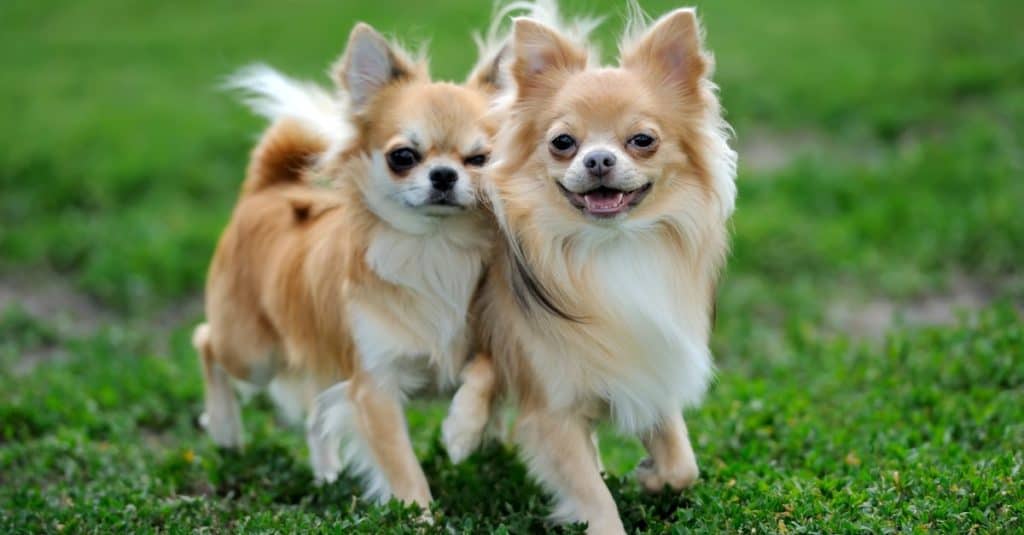
Two Longhair
Apple Head Chihuahua
dogs playing in green summer grass.
©Volodymyr Burdiak/Shutterstock.com
Toy dog breeds generally refer to dogs that are smaller than 15 pounds. Some of the most common toy breeds are chihuahuas, terriers, spaniels, and pinschers. Various species of dog are sometimes bred down in size to become toy breeds. Brands often cater to toy dogs to meet their specific dietary needs.
Age 0-1
Toy breeds may be small but just like other puppies, they need to eat more often than adult dogs. Puppies should eat about 3 times a day until they’re a year old. The amount of food given depends on the size of the dog. If a puppy is about 3 pounds it’d need ⅓ a cup of food. Once they reach between 6-10 pounds they can eat ¾ a cup.
Ages 1-10
By this age, your dog should be their full-grown size. Depending on their weight they’ll need between ¾ to 1 full cup of food twice a day. While it may be tempting to serve your dog a bigger portion or more than twice a day it’s important you stick to a feeding schedule. Once your pooch is fully grown you can talk to your vet about serving a more diverse diet or adding in any supplements.
Ages11+
Once a dog reaches around 10 years old it can be considered a senior dog. Depending on the breed, toy dogs have a lifespan of about 15 years though some may live until almost 20 if they live an active lifestyle with a healthy diet.
Once a dog reaches its senior years its metabolism is likely to slow down meaning it will process food differently. It’s best not to change your dog to senior food until its stomach no longer agrees with adult food. If your pooch starts to lose weight, which is very common for senior dogs, try upping the amount of food or changing to a food with a higher fat content.
Small Breeds (15-30lbs) Feeding Rules

Most small dogs require specific food to meet their dietary needs
©Mr. SUTTIPON YAKHAM/Shutterstock.com
Small breeds and toy breeds often get mixed up but small dogs are generally between 20 to 30 pounds when fully grown. Dogs in this range are more prone to health issues like mitral valve disease, tracheal collapse, and patellar luxation. They reach adulthood faster and need food that meets their dietary needs.
Age 0-1
Similar to toy breeds when small breeds are puppies they will need to eat more often than when they’re adults. While they’re growing and their weight is continually fluctuating it’s best to keep track of your puppies weight by weighing them every 2 to 4 weeks. When you have an accurate weight it’s easier to know how much they’ll need to eat. While their puppies aim to feed them at least ⅓ a cup and then a full cup once they reach ten pounds about 3 to 4 times a day.
Ages 1-10
When your furry friend becomes full grown you can get them on a feeding schedule to help maintain a healthy weight. By setting specific times of day and specific amounts of food for your pooch they are less likely to beg or cry for food when it’s not time to eat. Most small breed dogs are between 20 to 30 pounds once full grown so they’ll need about 1 ½ to 1 ¾ cups of food a day twice a day.
Ages11+
As your small dog ages, they’re bound to lose some weight and might even have less of an appetite than before. If that’s the case then it may be time to switch to senior food. If your pups’ appetite stays the same as they age there is no need to switch to senior food unless health problems arise and your vet suggests supplements or specific dog food to help them.
Medium Breeds (30-45lbs) Feeding Rules
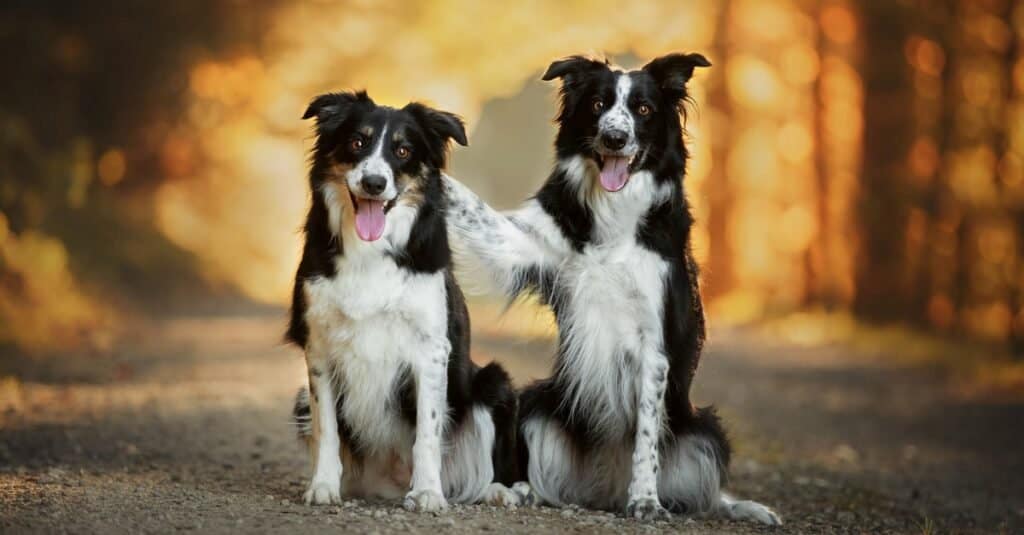
Border collies are a medium-sized breed of dog
©Lelusy/Shutterstock.com
Medium breed dogs are usually noticeably larger than most small breed dogs though they’re not quite as big as large breeds like golden retrievers or huskies. Australian shepherds, beagles, spaniels, bulldogs, basset hounds, and border collies are all examples of medium-breed dogs. The best way to tell if your dog is a medium breed is by weight. Typically medium dogs weigh between 30 to 40 pounds.
Age 0-1
Medium breed puppies usually reach about half their adult weight by five months of age so in the first few months of their life they’ll need to eat about 1 to 1 ⅓ cups of puppy food 4 times a day. Once they reach 6 months old they only need to eat about 3 times a day though the serving size will need to increase as they continue to grow. Once they reach 20 to 30 pounds they’ll need about 1 ¾ to 2 cups of food until they’re a year old.
Ages 1-10
Once fully grown medium-sized dogs can weigh up to 40 pounds. Depending on their weight you’ll need to adjust the feeding portion to about 2 to 2 ½ cups of adult dog food twice a day. To ensure your furry friend is eating the right amount you’ll need to factor in physical activity and current weight.
If your pooch is gaining a bit too much weight you may need to lessen the portions for a while. Be sure to check with your veterinarian if you plan to add supplements or change their food to ensure your dog is getting the right nutrients.
Ages11+
Medium breed dogs typically live to about 10 to 15 years, depending on lifestyle, with some breeds living even longer. If your pooch is active and eats a healthy amount of nutritious food they’ll probably live longer than pups with low activity levels or high body fat. When considering switching your pup to senior dog food you’ll have to look into which brands have the nutrients and ingredients your dog needs.
Typically when a dog switches to senior dog food it’s to help prevent or manage a disease or to increase their lifespan with a healthier diet. Senior dogs need about the same amount as they’re used to. It’s only recommended to increase the serving size if your dog is starting to lose weight or they are only eating once per day rather than twice.
Large Breeds (50-90lbs) Feeding Rules
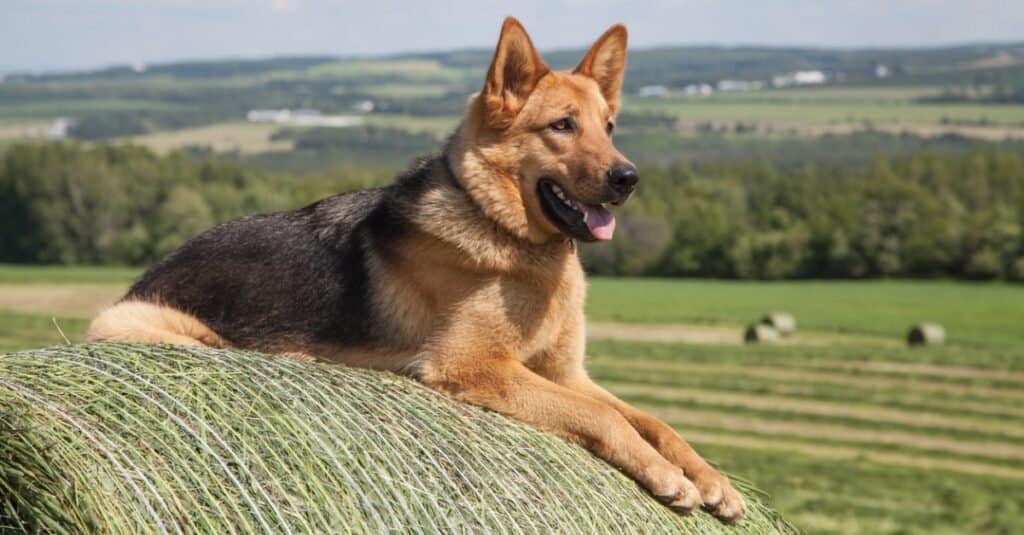
German Shepherds are smart, loyal, affectionate dogs that have a strong protective streak.
©iStock.com/Lurin
Large breed dogs can weigh almost 100 pounds once they’re fully grown. Even when puppies they will probably weigh between 25 to 40 pounds. Large breed dogs include the Bernese mountain dog, german shepherd, and st. bernard. Large dogs have special food for their size. Check out the best large-breed dog foods for 2022.
Age 0-1
Large breed puppies gain about 2 pounds per week and once they’re weaned off milk around a month old they will probably be close to 10 pounds. Large breed puppies should start at about ¾ a cup of puppy food and eat about 4 times a day. As their weight increases to about 20 pounds, their serving size should increase to about 1 ½ cups of food. 30 pounds should be around 2 cups of food 4 times a day.
Once they reach 40 to 50 pounds they should be about 6 months old so you can expect to feed them 2 ½ to 2 ¾ cups about 3 times a day. At 6 months to a year old continue to feed them about 3 times a day. From 50 to 70 pounds feed them about 3 cups of food. When weighing 70 to 100 pounds 3 ½ to 4 cups should be enough. Be sure to adjust based on your dog’s physical activity and how much they tend to eat per feeding. If they aren’t finishing their food at mealtimes try to decrease the amount by about 1 or 1 ½ cups.
Ages 1-10
Large breed dogs take longer than smaller breeds to reach their full grown height and weight because the growth plates in the bones take longer to close. At around 12 to 18 months your pooch should be fully grown and weigh between 70 to 90 pounds. Around this time you should be starting to feed your dog large breed adult dog food twice a day instead of three times a day. The amount will probably stay the same at about 3 to 4 cups of food depending on your pooch’s appetite.
Ages11+
If your large breed dog is older but is continuing to eat a healthy well-balanced diet there is no need to switch to senior food. If you feel your furry friend needs more nutrients or more specific vitamins try to find an adult dog food that works best with their dietary needs. Only switch to senior food if it’s recommended by your veterinarian.
Giant Dog Breeds (90lbs+) Feeding Rules
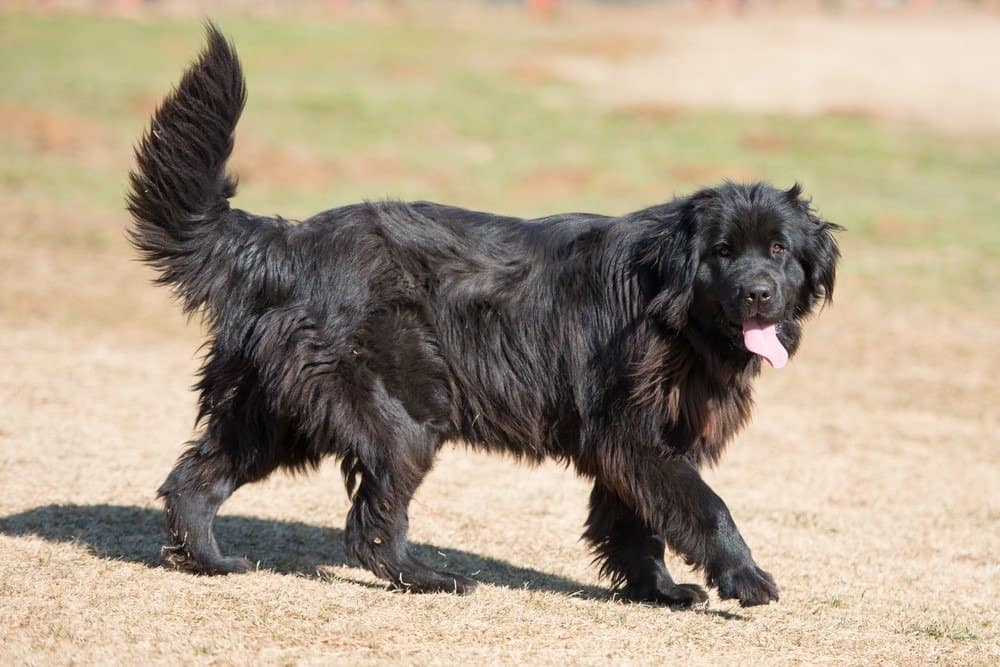
Newfoundlands are a giant breed of dog which require a lot of food
©Purino/Shutterstock.com
Most giant dog breeds reach well over 100 pounds and are usually much slower to mature mentally and physically than other sizes. Because these breeds are so much bigger they will need a considerably larger amount of food than other dogs. You should expect to be paying a lot more for food than small, medium, and even large breed dog owners.
Age 0-1
As we’ve established, giant breed dogs grow at a slower rate than other sizes. It will take about 18 months for your pup to become fully grown though some breeds can take almost 24 months to reach their full-grown height and weight. By the time giant breed puppies are weaned off milk, they will probably be between 15 to 20 pounds so they should start off with about a cup of puppy food 4 times a day.
At around 4 months they will likely be at least 50 pounds so their portions should increase to about 2 maybe 2 ½ cups of food 4 times a day. Once they reach about 6 to 8 months they should weigh around 70 to 80 pounds and should be eating about 3 to 3 ½ cups of food per meal though you can decrease mealtimes to 3 times a day at this point. They will probably continue to eat this much until they’re around 100 pounds then the portions should increase to about 4 cups twice a day.
Ages 1-10
When giant dog breeds reach their full grown size at one or two years old they will most likely weigh around 150 pounds. Around 2 years of age would be the best time to switch your pooch to adult dog food for extra large breeds. After your dog surpasses 100 pounds you will need to add an additional ⅓ to ¼ cup of food for every ten pounds of body weight. While it is recommended to add joint supplements to giant dogs’ diets, be sure to check with your veterinarian if it’s safe for your specific dog.
Ages10+
While giant breed dogs do mature slower they age at a faster rate once they become adults. Because of this extra large dog breeds tend to have a shorter lifespan than smaller breeds. They only live to about 10 years old though with good exercise and diet then can live to be around 15.
Giant breed dogs are more prone to medical conditions like tumors, and different types of cancer. Your pooch may show signs that its metabolism is changing as early as 7 years old. Once you see signs your furry friend may need a new diet or senior food be sure to talk to your vet so you can know exactly what vitamins and nutrients your dog needs.
Bonus: Can I feed my dog people food?
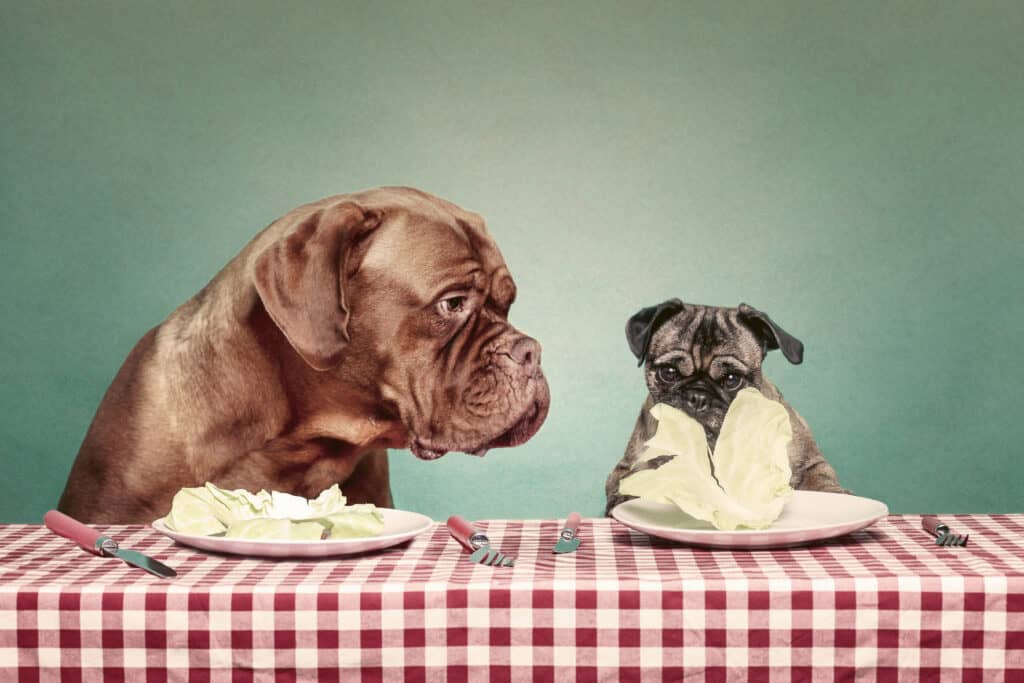
There are many people foods that your dog can eat – including some vegetables.
©David Charles Cottam/Shutterstock.com
If you have ever had a dog and have brought home a rotisserie chicken from the grocery store – you know that as soon as your pet smells the chicken aroma – you will be subjected to a relentless begging quest from your pup that will inevitably end in you giving in. Is it okay to give in? In the case of chicken – yes, as long as the seasoned skin and bones are removed. Be sure to offer your pet bite-sized portions and make sure that the chicken isn’t too hot.
It is generally fine for dogs to eat well-cooked, unseasoned meat in bite-sized pieces. Eggs are also good if they are cooked and unsalted. Raw egg whites can contribute to biotin deficiency – so refrain from offering them to your dog. Cheese and peanut butter are also good occasional treats. A tiny bite of cooked bacon on occasion is okay – but remember that bacon contains way too much salt for your dog and can make him sick. Occasional bites of unseasoned baked or sweet potato will be a welcomed treat but don’t give your pet potatoes slathered in butter. Some pet owners prefer to prepare fresh meals for their dogs instead of buying commercial food. If you should choose that route – please do some research and ask your vet to advise you.
The photo featured at the top of this post is © Dmytro Zinkevych/Shutterstock.com
Ready to discover the top 10 cutest dog breeds in the entire world?
How about the fastest dogs, the largest dogs and those that are -- quite frankly -- just the kindest dogs on the planet? Each day, AZ Animals sends out lists just like this to our thousands of email subscribers. And the best part? It's FREE. Join today by entering your email below.
Thank you for reading! Have some feedback for us? Contact the AZ Animals editorial team.






